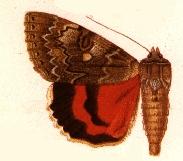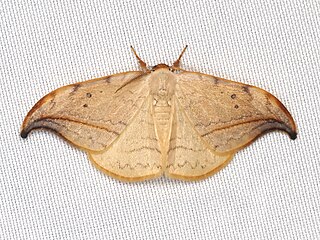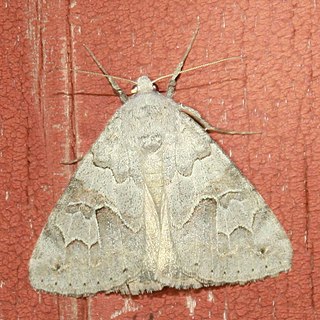
Drasteria is a genus of moths in the family Erebidae.

Catocala californica is a moth of the family Erebidae first described by William Henry Edwards in 1864. It is found in western North America from British Columbia and Alberta south through Washington and Oregon to California.

Catocala hermia, the Hermia underwing, is a moth of the family Erebidae. The species was first described by Henry Edwards in 1880. It is found throughout the Great Plains of North America, from southern Saskatchewan and Alberta south and west to Texas, Arizona and California.

Caenurgina annexa, the banded grass moth, is a moth of the family Erebidae. The species was described by Henry Edwards in 1890. It is found in western North America from western Alberta and Montana to British Columbia, Washington, and Oregon.

Drasteria adumbrata, the shadowy arches, is a moth of the family Erebidae. The species was first described by Hans Hermann Behr in 1870. It is found from coast to coast in southern Canada, south in the west to California and Colorado, south in the east to New England and Michigan. Subspecies D. a. alleni is found from eastern Alberta to New York and Nova Scotia. Subspecies D. a. saxea occurs from southern British Columbia and south-west Alberta south to California and Colorado.
Drasteria hudsonica, the northern arches, is a moth of the family Erebidae. The species was first described by Augustus Radcliffe Grote and Coleman Townsend Robinson in 1865. It is found from Alaska and Yukon to California, east to New Mexico and Manitoba.

Drasteria pallescens, the cowhead arches, is a moth of the family Erebidae. The species was first described by Augustus Radcliffe Grote and Coleman Townsend Robinson in 1866. It is found in North America from Alberta and Saskatchewan south to Texas and Baja California.
Drasteria petricola, the little arches, is a moth of the family Erebidae. The species was first described by Francis Walker in 1858. It is found in western North America from Yukon and the Northwest Territories south to New Mexico in the Rocky Mountains, east to Manitoba.

Drasteria sabulosa is a moth of the family Erebidae. It is found from British Columbia south into the United States where it found as far east as Wyoming, Utah, Colorado, New Mexico and as far south as Arizona.
Drasteria hastingsii is a moth of the family Erebidae. It is found from British Columbia south to Oregon and California.
Drasteria mirifica is a moth of the family Erebidae. It is found in North America, including Nevada, Oregon and California.

Drasteria fumosa, the smoky arches, is a species of moth in the family Erebidae first described by Strecker in 1898. It is found from the US state of California east to Utah and Texas.
Drasteria inepta, the inept drasteria, is a moth of the family Erebidae. It is found from Arizona to Texas, north to Colorado and Utah.

Heliothis oregonica, the Oregon gem, is a moth of the family Noctuidae. The species was first described by Henry Edwards in 1875. It is found in North America from the Peace River area of Alberta south and west in the mountains to California and Arizona. There is also a disjunct population in north central Quebec.

Idia occidentalis is a species of litter moth of the family Erebidae first described by Smith in 1884. It is found in North America from southern Alberta and British Columbia, south to Colorado, Arizona and California.

Drepana arcuata, the arched hooktip or masked birch caterpillar, is a moth of the family Drepanidae. The species was first described by Francis Walker in 1855. It is found from Newfoundland to Vancouver Island, south to at least North Carolina, South Carolina and California.

Aspitates aberrata is a moth of the family Geometridae first described by Henry Edwards in 1884. It is found in North America from northern Minnesota north and west across southern Manitoba to western Alberta and the Peace River area of British Columbia. The habitat consists of open aspen parklands and low elevation grasslands.
Drasteria biformata is a moth of the family Erebidae. It is found in North America, where it has been recorded from Arizona and California.
Drasteria occulta, the occult drasteria moth, is a moth of the family Erebidae. The species was first described by Henry Edwards in 1881. It is found in North America, where it has been recorded from coastal areas in Maine, New Jersey, Pennsylvania and Texas. It is listed as a species of special concern and believed extirpated in the US state of Connecticut.

Drasteria scrupulosa is a moth of the family Erebidae. It is found in North America, where it has been recorded from California, Idaho, Nevada, Oregon and Utah. The habitat consists of open sagebrush steppes.









